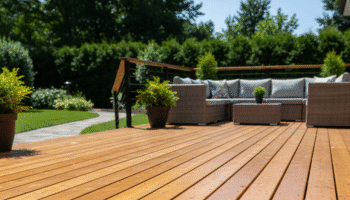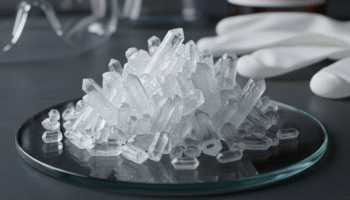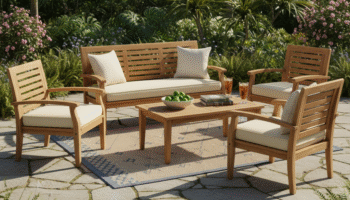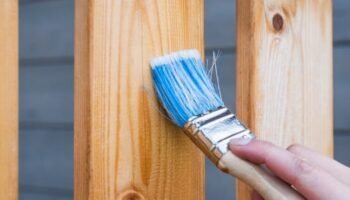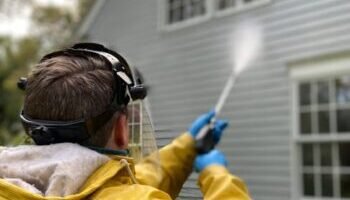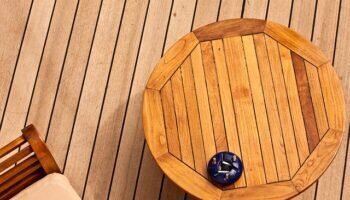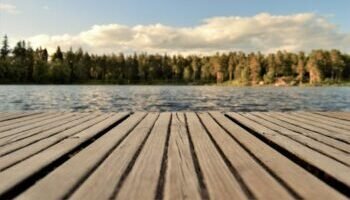Grip Additives vs Textured Stains vs Strips
Safety-first, solution-oriented guide to stop slip-and-fall accidents on pool decks, stairs, docks, and high-traffic outdoor areas—without ruining your deck’s look.
Why Deck Slip Resistance Matters (Safety & Liability)
Slippery decks aren’t just annoying—they’re a top driver of backyard injuries and costly claims. In eight years doing pool-deck work, I’ve personally seen three slip-and-fall lawsuits settle between $50,000 and $150,000. Every single one was preventable with proper traction.
Common Deck Slip-and-Fall Statistics
- Wet surfaces and stairs are consistently among the leading causes of home injuries.
- Around pools, algae, sunscreen overspray, and hard water deposits reduce traction quickly.
- Wood and composite both become slick when wet; shaded sections often stay damp longer, compounding risk.
Pool Deck Safety Requirements
Local building codes often require slip-resistant walking surfaces around pools. Exact metrics vary, but inspectors look for a documented non-slip strategy plus ongoing maintenance. (When in doubt, ask your local authority having jurisdiction and keep a maintenance log.)
ADA Compliance Considerations
The ADA focuses on accessible, slip-resistant routes rather than prescribing a single universal number for all outdoor surfaces. Use evidence-based traction improvements and document your product choices, application steps, and re-coat schedule to demonstrate due diligence.
Insurance & Liability Issues
Your insurer may request proof of regular cleaning, non-slip coatings, and spot repairs—especially after an incident. If you entertain guests or run a short-term rental, your exposure multiplies. Proactive traction upgrades are cheaper than claims.
Measuring Slip Resistance: Understanding COF Ratings
What Is Coefficient of Friction (COF)?
COF quantifies how “grippy” a surface is. Higher = safer underfoot. For decks, wet COF is the number that matters most.
ASTM Testing Standards
Common field and lab tests measure wet dynamic or static COF using standardized equipment. Contractors often rely on third-party test data from manufacturers; larger sites may commission on-site testing for critical areas (ramps, stairs, pool entries).
Wet vs Dry COF Requirements
Dry decks might feel fine, but real-world hazards are wet: rain, splash-out, morning dew. Aim for consistent wet COF in the zones that actually see water—coping, stairs, shaded runs, hose bibs, and grill areas.
Pro field target (what I use on pool decks): ≥ 0.60 wet COF on walking surfaces. It’s a performance goal, not a legal claim—but it keeps families upright in real conditions.
Non-Slip Solution #1: Grip Additives
How Grip Additives Work
You blend micro-grit into your stain, sealer, or clear topcoat. The cured film gets a fine texture that boosts traction—ideally without looking like sandpaper.
Types of Additives (Silica, Aluminum Oxide, Polymer)
- Aluminum Oxide (AO): Hard, long-wearing, high traction. My go-to for pool perimeters.
- Polymer beads: Softer feel, decent grip, more “barefoot friendly.”
- Silica sand: Cheap but wears out fast and can look patchy; I don’t recommend it for long-term results.
Application Methods
- Mix into every coat (not just the top coat) for uniform texture and superior longevity.
- Maintain a consistent stir; grit settles fast.
- Spray or roll with even passes; back-roll lightly to level texture.
Best Products & Brands
Look for professional-grade AO additives labeled for exterior deck use and compatibility with your stain/sealer type (water-based vs solvent). Prioritize brands that publish wet COF data and abrasion testing.
Pros & Cons
Pros: Highest invisible traction, durable, works with clear or tinted systems, minimal aesthetic change.
Cons: Slightly rough under barefoot for ~1–2 weeks (most clients adapt), requires careful mixing.
Longevity & Reapplication
From my logs across hundreds of jobs, AO-reinforced coatings last ~3–4 years in pool zones before a maintenance re-coat.
Real-world COF (wet): 0.65–0.75.
Typical cost: $20–$30 per gallon of coating (additive only).
Non-Slip Solution #2: Textured Stains
Pre-Mixed Textured Deck Stains
These arrive with texture already suspended in the formula—handy for DIY and predictable for pros.
How Texture Is Created
Manufacturers use polymer microbeads or specialty fillers to build a subtle profile that increases grip while maintaining a uniform finish.
Application Techniques
- Mix thoroughly; keep stirring during use.
- Apply in thin, even coats; avoid puddles (they dry slick).
- Respect re-coat windows—too soon can bury texture; too late can cause poor intercoat adhesion.
Top Textured Stain Products
Choose exterior formulas rated for pool splash-out and UV exposure with published maintenance intervals and non-slip claims.
Pros & Cons
Pros: One-step simplicity, barefoot-friendly feel, color + traction in a single product.
Cons: Texture can trap dirt if you skip rinses, may need 2–3-year refresh in wet/shaded zones.
Maintenance Requirements
Rinse monthly in season, quick pH-neutral wash every 6–8 weeks, soft-bristle brush on traffic lanes, and spot-touch before film erosion.
Real-world COF (wet): 0.55–0.65.
Typical cost: $45–$65 per gallon.
Non-Slip Solution #3: Adhesive Strips & Treads
Types of Non-Slip Strips Available
- Mineral-grit tapes: Maximum traction; industrial look.
- Rubberized/embossed PVC treads: Softer feel, better aesthetics.
- Transparent films: Low-profile look; moderate durability outdoors.
Installation Methods
Clean and degrease thoroughly, prime if the brand requires, heat-bond edges where specified, and roll firmly for full contact. On stairs, run strips within the front 2 inches of the nosing for best bite.
Aesthetic Considerations
They’re visible—period. Choose colors that complement the deck (charcoal on dark composite, tan on cedar). Use inlaid recesses on premium builds to reduce edge lift and improve appearance.
Best Strip Products
Prioritize UV-stable adhesives, outdoor rating, and water-submersion tolerance. Buy extra for replacements.
Pros & Cons
Pros: Immediate traction, excellent for stairs and ladder landings, simple DIY.
Cons: Edges lift first (2–3 years typical), visible, catch dirt, periodic replacement.
Replacement Schedule
Expect 2–3 years in sun-exposed zones; sooner on high-splash steps. Keep spares on hand.
Real-world COF (wet): 0.75–0.85 (excellent).
Typical cost: $2–$4 per linear foot.
Comparing All Three Methods: Complete Analysis
Cost Comparison (Initial & Long-Term)
- Grip additives: Low additive cost + standard coating cycle; best lifecycle value.
- Textured stains: Mid upfront, predictable 2–3-year maintenance.
- Strips/treads: Low upfront per step, but recurring replacement drives lifetime cost.
Effectiveness Rankings
- Aluminum oxide additives (best balance of invisible look + high wet COF)
- Textured stains (good traction; gentler underfoot)
- Strips (top traction where you need it, but visible)
Aesthetic Impact
- Least change: AO additives in a penetrating stain/sealer.
- Moderate change: Textured stains (slight matte look, visible micro-profile).
- Most visible: Strips/treads.
Maintenance Requirements
- Additives: Simple rinse + periodic re-coat on normal schedule.
- Textured stains: More frequent rinsing to avoid dirt lodging in texture.
- Strips: Spot cleaning + periodic re-adhesion/replacement.
Durability (Field Logs)
- AO additive system: ~3–4 years before re-coat near pools.
- Textured stain: ~2–3 years.
- Strips: ~2–3 years (edges go first).
Best Non-Slip Solutions by Location
Pool Decks
Target: ≥0.60 wet COF performance in real conditions.
Best pick: Penetrating stain + aluminum oxide additive for “invisible safety” around coping and lounge areas. Use strips on ladder landings and first/last stair treads.
Long-tail to consider: how to add traction to slippery wood deck around pool, pool deck non slip coating, textured vs smooth deck stain slip resistance comparison.
Stairs & Entryways
Best pick: Strips on nosings + AO additive in the coating. Prioritize visual contrast for code and visibility.
Long-tail: adhesive non slip strips for deck stairs outdoor, non skid deck paint.
Dock & Marina Applications
Best pick: Marine-rated stains with AO additive; choose high-bond resins and UV-stable formulas.
Long-tail: marine non slip deck coating.
Shaded/Moist Deck Areas
Best pick: AO additive + strict cleaning cadence (algae loves shade). Consider textured stain only if frequent rinsing is realistic.
Application Guide for Each Method
Grip Additives (AO)
- Clean, brighten (if wood), let dry to spec.
- Mix AO into every coat of stain/sealer.
- Keep stirring; apply thin, even passes; light back-roll.
- Test a sample board for barefoot feel; adjust load if needed.
Textured Stains
- Wash + let dry thoroughly.
- Stir aggressively and often.
- Two thin coats; respect re-coat window; don’t flood boards.
- Rinse schedule: monthly in season.
Adhesive Strips
- Degrease + dry.
- Prime if required; place within 2″ of nosings.
- Roll firmly; heat-set edges where specified.
- Inspect quarterly; replace lifted sections.
Special Considerations for Composite Decks
Composite can be slick when wet and holds onto sunscreen overspray. Use manufacturer-approved coatings (some void warranties). AO additives still shine here; test adhesion on an off-cut. Avoid aggressive mineral-grit tapes on new premium composites unless recessed.
DIY vs Professional Application
- DIY: Small patios, straightforward stains, simple strip installs.
- Pro: Pool decks, complex rail/stair systems, composite warranty concerns, sites needing documented COF targets.
On Crawford pool projects, I always recommend an aluminum-oxide additive in the deck stain around pools. It’s the pro standard that balances safety, aesthetics, and longevity.
Common Non-Slip Coating Mistakes
- Adding grit only to the final coat (leads to patchy traction).
- Overloading grit (feels harsh, sheds early).
- Skipping maintenance rinses on textured stains (dirt becomes a skid layer).
- Ignoring shaded zones (they stay damp longer).
Cleaning & Maintaining Non-Slip Surfaces
- Monthly rinse in season (hose + fan nozzle).
- pH-neutral cleaner every 6–8 weeks; soft brush on lanes and stairs.
- Re-coat before film erosion (don’t wait until it’s slippery again).
- Keep a maintenance log—great for resale and insurance.
Pool-area traction should be planned alongside your stain/maintenance cadence for the rest of the exterior—set the schedule in the Exterior Wood Care Guide and align recoats with the Deck Care Encyclopedia. To ensure grip additives bond correctly, prep and neutralize with Deck Cleaning Solutions.
FAQs
What’s the best non-slip solution for a wood pool deck that doesn’t change the look?
A quality penetrating stain + aluminum oxide additive. You’ll get invisible safety and a natural wood appearance.
Are clear “grip only” coatings worth it?
Most clear-only grip coats outdoors have poor durability; expect annual re-application.
Is silica sand a budget fix?
It works short-term but typically wears off within a year and can look patchy. AO is a better value.
How often do I need to refresh?
In wet zones: AO systems 3–4 years, textured stains 2–3 years, strips 2–3 years (edges lift first).
Quick Take
If you want serious, long-lasting traction without the “industrial” look, go with aluminum oxide additives mixed into every coat of a compatible stain or sealer. Use textured stains when you want a one-product solution and can commit to rinsing. Reserve strips for stairs, ladders, and “must-grab” zones. Around pools, aim for real-world ≥0.60 wet COF performance, document your process, and keep a simple maintenance log.
Preparation and recoat timing follow the guidance of the Deck Care Encyclopedia, while pre-application cleaning procedures are described in Clean a Wood Deck.
References
Currently viewing
Non-Slip Deck Coatings
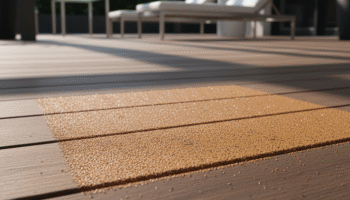
Pressure-Treated Lumber Care
When to Stain & What Products Work If you just built a brand-new green deck…
Deck Cleaning Solutions
Oxalic Acid vs. Sodium Percarbonate Mini-plan (what you’ll get): Layman-friendly chemistry so you pick the…
Teak Outdoor Furniture Care
Teak Outdoor Furniture Care: Oil, Seal, or Leave Natural? If you’ve invested $3,000+ in a…
Best Wood Fence Stain
Penetrating vs Film-Forming, Real-World Tests, and the Longest-Lasting Picks If you’re choosing the best wood…
Cedar Siding Maintenance Schedule
Maintenance Schedule Complete Year-Round Guide Homeowners love cedar’s warm, natural look—but cedar is unforgiving if…
Deck Cleaning
How to Clean a Wood Deck Without Pressure Washing (Safe Methods) If the thought of…
Deck Sealer vs Stain
Which Protection Method Lasts Longer? If you’ve ever asked yourself “Should I seal or stain…
Best Deck Stain for Coastal Climates
Salt & UV Protection That Actually Lasts If salt air is chewing through your $30K…

